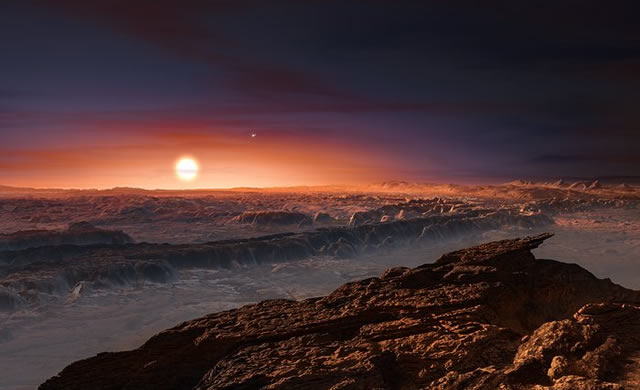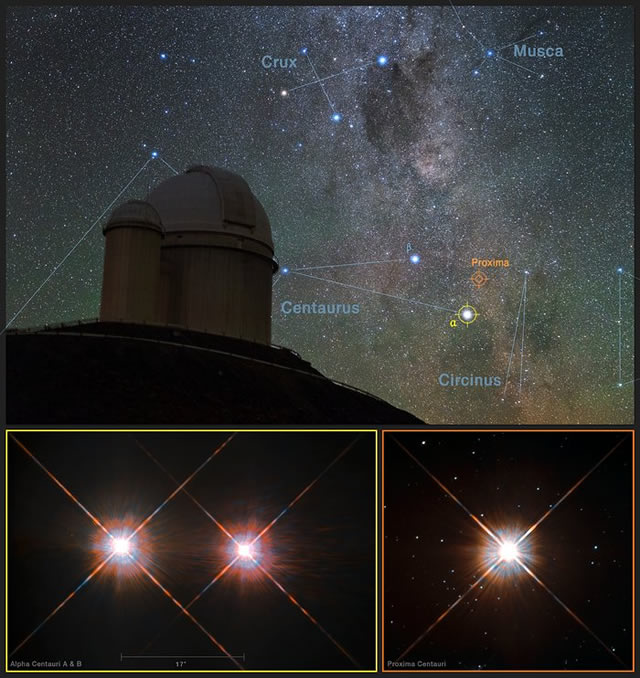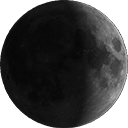
Credits: Credit: ESO/M. Kornmesser
Trovato un pianeta all’interno della zona abitabile della stella più vicina a noi – La campagna “Pale Red Dot” (Piccolo Punto Rosso) rivela un mondo di massa simile a quella della Terra in orbita intorno a Proxima Centauri. Alcuni astronomi, utilizzando i telescopi dell’ESO e altri strumenti hanno trovato una chiara prova della presenza di un pianeta in orbita intorno alla stella più vicina alla Terra, Proxima Centauri. Questo mondo così a lungo cercato, designato Proxima b, orbita ogni 11 giorni intorno alla stella madre, rossa e fredda, e ha una temperatura tale che l’eventuale acqua presente in superficie rimane liquida. Questo mondo roccioso ha una massa poco maggiore di quella della Terra ed è l’esopianeta più vicino a noi – potrebbe anche essere il più vicino ricettacolo di vita fuori dal Sistema Solare. Un articolo che descrive questa scoperta epocale verrà pubblicato dalla rivista Nature il 25 agosto 2016.
A poco più di 4 anni luce dal Sistema Solare si trova una nana rossa, chiamata Proxima Centauri perchè è la stella più vicina alla Terra, escluso naturalmente il Sole. Questa stella fredda si trova nella costellazione del Centauro: è troppo debole per essere vista a occhio nudo ma è vicina a una coppia di stelle molto più brillanti, nota come Alfa Centauri AB. Nella prima metà del 2016 Proxima Centauri è stata osservata con regolarità dallo spettrografo HARPS montato sul telescopio da 3,6 metri dell’ESO all’Osservatorio di La Silla in Cile e simultaneamente da altri telescopi in tutto il mondo. Questa campagna, in cui un gruppo di astronomi, guidati da Guillem Anglada-Escudé, della Queen Mary University di Londra, cercava le piccolissime oscillazioni della stella causate dall’attrazione gravitazionale di un putativo pianeta in orbita intorno alla stella, fu denominata Piccolo Punto Rosso (“Pale Red Dot” in inglese). Essendo un argomento di grande interesse per il pubblico, i progressi della campagna sono stati condivisi in tempo reale, tra metà gennaio e aprile 2016, attraverso il sito “Pale Red Dot” e i social media. I rapporti erano sempre accompagnati da articoli divulgativi scritti da specialisti internazionali. Guillem Anglada-Escudé spiega il contesto di questa ricerca, unica al mondo: “Il primo indizio che ci fosse un pianeta è stato trovato nel 2013, ma le misure non erano convincenti. Da allora abbiamo lavorato duramente per ottenere altre osservazioni da terra, con l’aiuto dell’ESO e di altre istituzioni. La recente campagna “Pale Red Dot” ha richiesto due anni di pianficazione.”
Fonte/Leggi tutto → ESO.org

Proxima b, Proxima Centauri – Credits: Y. Beletsky (LCO)/ESO/ESA/NASA/M. Zamani
Planet Found in Habitable Zone Around Nearest Star – Pale Red Dot campaign reveals Earth-mass world in orbit around Proxima Centauri. Astronomers using ESO telescopes and other facilities have found clear evidence of a planet orbiting the closest star to Earth, Proxima Centauri. The long-sought world, designated Proxima b, orbits its cool red parent star every 11 days and has a temperature suitable for liquid water to exist on its surface. This rocky world is a little more massive than the Earth and is the closest exoplanet to us — and it may also be the closest possible abode for life outside the Solar System. A paper describing this milestone finding will be published in the journal Nature on 25 August 2016.
Just over four light-years from the Solar System lies a red dwarf star that has been named Proxima Centauri as it is the closest star to Earth apart from the Sun. This cool star in the constellation of Centaurus is too faint to be seen with the unaided eye and lies near to the much brighter pair of stars known as Alpha Centauri AB. During the first half of 2016 Proxima Centauri was regularly observed with the HARPS spectrograph on the ESO 3.6-metre telescope at La Silla in Chile and simultaneously monitored by other telescopes around the world. This was the Pale Red Dot campaign, in which a team of astronomers led by Guillem Anglada-Escudé, from Queen Mary University of London, was looking for the tiny back and forth wobble of the star that would be caused by the gravitational pull of a possible orbiting planet. As this was a topic with very wide public interest, the progress of the campaign between mid-January and April 2016 was shared publicly as it happened on the Pale Red Dot website and via social media. The reports were accompanied by numerous outreach articles written by specialists around the world. Guillem Anglada-Escudé explains the background to this unique search: “The first hints of a possible planet were spotted back in 2013, but the detection was not convincing. Since then we have worked hard to get further observations off the ground with help from ESO and others. The recent Pale Red Dot campaign has been about two years in the planning.”
Source/Continue reading → ESO.org






















cara deneb, quanto tempo che non ti scrivo, mi chiedevo…quanto ci metteremmo per raggiungerla con i mezzi che dispone la NASA attualmente o che disporrà in questi prossimi decenni?
ps: dove posso scrivere domande per evitare che tutti le leggano? poiche avevo un idea per un sito web sull’ astronomia ma volevo sentire il tuo parere per vedere se può essere fattibile
(scusa se il ps non centra con l’ argomento)
Ciao Alex!
Per inviare una mail puoi usare il modulo alla pagina contatti raggiungibile dalla voce del menu “Contact me”!
grazie, e per quanto riguarda il tempo per raggiungere la “nuova terra” si hanno già delle stime?
Ciao Alex,
credo ci sia una bella differenza tra il raggiungere fisicamente la “nuova terra” e poterla osservare un po’ più da vicino.
Con la prossima generazione di telescopi spaziali, penso a Webb, sarà più facile dare un’occhiatina “ravvicinata”.
Non resta che attendere il suo lancio previsto per il 2018!